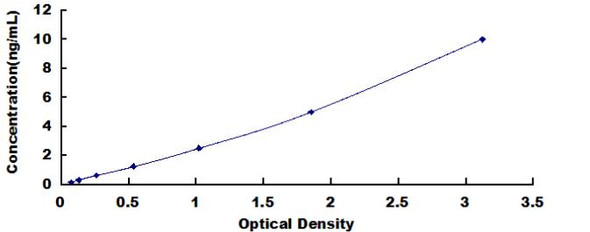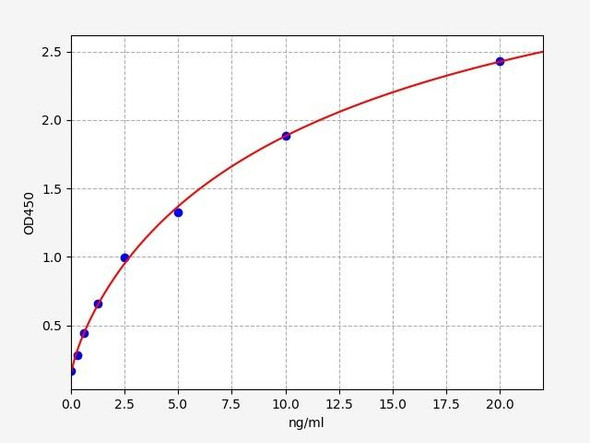Mouse Immunology ELISA Kits
Mouse TLR4 ELISA Kit
- SKU:
- MOFI00287
- Product Type:
- ELISA Kit
- Size:
- 96 Assays
- Uniprot:
- Q9QUK6
- Sensitivity:
- 0.188ng/ml
- Range:
- 0.313-20ng/ml
- ELISA Type:
- Sandwich
- Synonyms:
- TLR4, CD284, ARMD10, CD284 antigen, Lps, hTollhomolog of Drosophila toll, TOLL, toll-like receptor 4
- Reactivity:
- Mouse
- Research Area:
- Immunology
Description
| Product Name: | Mouse TLR4 ELISA Kit |
| Product Code: | MOFI00287 |
| Size: | 96 Assays |
| Alias: | TLR4, CD284, ARMD10, CD284 antigen, Lps, hTollhomolog of Drosophila toll, TOLL, toll-like receptor 4 |
| Detection Method: | Sandwich ELISA |
| Application: | This immunoassay kit allows for the in vitro quantitative determination of Mouse TLR4 concentrations in serum plasma and other biological fluids. |
| Sensitivity: | 0.188ng/ml |
| Range: | 0.313-20ng/ml |
| Storage: | 4°C for 6 months |
| Note: | For Research Use Only |
| Recovery: | Matrices listed below were spiked with certain level of Mouse TLR4 and the recovery rates were calculated by comparing the measured value to the expected amount of Mouse TLR4 in samples. | ||||||||||||||||
| |||||||||||||||||
| Linearity: | The linearity of the kit was assayed by testing samples spiked with appropriate concentration of Mouse TLR4 and their serial dilutions. The results were demonstrated by the percentage of calculated concentration to the expected. | ||||||||||||||||
| |||||||||||||||||
| Intra Assay: | CV <8% | ||||||||||||||||
| Inter Assay: | CV <10% |
| Component | Quantity | Storage |
| ELISA Microplate (Dismountable) | 8-12 strips | 4°C for 6 months |
| Lyophilized Standard | 2 | 4°C/-20°C |
| Sample/Standard Dilution Buffer | 20ml | 4°C |
| Biotin-labeled Antibody(Concentrated) | 120ul | 4°C (Protect from light) |
| Antibody Dilution Buffer | 10ml | 4°C |
| HRP-Streptavidin Conjugate(SABC) | 120ul | 4°C (Protect from light) |
| SABC Dilution Buffer | 10ml | 4°C |
| TMB Substrate | 10ml | 4°C (Protect from light) |
| Stop Solution | 10ml | 4°C |
| Wash Buffer(25X) | 30ml | 4°C |
| Plate Sealer | 5 | - |
Other materials and equipment required:
- Microplate reader with 450 nm wavelength filter
- Multichannel Pipette, Pipette, microcentrifuge tubes and disposable pipette tips
- Incubator
- Deionized or distilled water
- Absorbent paper
- Buffer resevoir
| Uniprot | Q9QUK6 |
| UniProt Protein Function: | TLR4: Cooperates with LY96 and CD14 to mediate the innate immune response to bacterial lipopolysaccharide (LPS). Acts via MYD88, TIRAP and TRAF6, leading to NF-kappa-B activation, cytokine secretion and the inflammatory response. Also involved in LPS- independent inflammatory responses triggered by Ni(2+). These responses require non-conserved histidines and are, therefore, species-specific. Belongs to the lipopolysaccharide (LPS) receptor, a multi-protein complex containing at least CD14, LY96 and TLR4. Binding to bacterial LPS leads to homodimerization. Interacts with LY96 via the extracellular domain. Interacts with MYD88 and TIRAP via their respective TIR domains. Interacts with NOX4. Interacts with CNPY3. Interacts with HSP90B1. The interaction with both CNPY3 and HSP90B1 is required for proper folding in the endoplasmic reticulum. Highly expressed in placenta, spleen and peripheral blood leukocytes. Detected in monocytes, macrophages, dendritic cells and several types of T-cells. Belongs to the Toll-like receptor family. 3 isoforms of the human protein are produced by alternative splicing. |
| UniProt Protein Details: | Protein type:Receptor, misc.; Membrane protein, integral Cellular Component: cell surface; cytoplasm; external side of plasma membrane; integral to plasma membrane; intrinsic to plasma membrane; lipid raft; lipopolysaccharide receptor complex; perinuclear region of cytoplasm; plasma membrane Molecular Function:lipopolysaccharide binding; lipopolysaccharide receptor activity; phosphoinositide 3-kinase binding; protein binding; receptor activity Biological Process: activation of innate immune response; activation of MAPK activity; activation of NF-kappaB transcription factor; astrocyte development; B cell proliferation during immune response; defense response to Gram-negative bacterium; detection of lipopolysaccharide; I-kappaB phosphorylation; innate immune response; innate immune response-activating signal transduction; interferon-gamma production; interleukin-1 beta secretion; leukotriene metabolic process; lipopolysaccharide-mediated signaling pathway; macrophage activation; microglial cell activation; negative regulation of interferon-gamma production; negative regulation of interleukin-17 production; negative regulation of interleukin-23 production; negative regulation of interleukin-6 production; negative regulation of tumor necrosis factor production; positive regulation of apoptosis; positive regulation of B cell proliferation; positive regulation of chemokine production; positive regulation of DNA binding; positive regulation of I-kappaB kinase/NF-kappaB cascade; positive regulation of inflammatory response; positive regulation of interferon-alpha production; positive regulation of interferon-beta biosynthetic process; positive regulation of interferon-beta production; positive regulation of interferon-gamma production; positive regulation of interleukin-1 production; positive regulation of interleukin-10 production; positive regulation of interleukin-12 biosynthetic process; positive regulation of interleukin-12 production; positive regulation of interleukin-6 production; positive regulation of interleukin-8 biosynthetic process; positive regulation of interleukin-8 production; positive regulation of JNK cascade; positive regulation of lymphocyte proliferation; positive regulation of MHC class II biosynthetic process; positive regulation of NF-kappaB import into nucleus; positive regulation of nitric oxide biosynthetic process; positive regulation of nitric-oxide synthase biosynthetic process; positive regulation of peptidyl-tyrosine phosphorylation; positive regulation of stress-activated MAPK cascade; positive regulation of transcription factor activity; positive regulation of transcription from RNA polymerase II promoter; positive regulation of tumor necrosis factor biosynthetic process; positive regulation of tumor necrosis factor production; production of nitric oxide during acute inflammatory response; regulation of dendritic cell cytokine production; regulation of inflammatory response; regulation of sensory perception of pain; response to bacterium; response to ethanol; response to lipopolysaccharide; response to oxidative stress; toll-like receptor signaling pathway |
| NCBI Summary: | This gene belongs to the evolutionarily-conserved Toll-like receptor family, whose members are type-1 transmembrane proteins that are involved in innate immunity. Toll-like receptors are characterized by an extracellular leucine-rich repeat domain that functions in ligand recognition and an intracellular toll/interleukin-1 receptor-like domain that is crucial for signal transduction. The receptor encoded by this gene mediates the innate immune response to bacterial lipopolysaccharide, a major component of the outer membrane of Gram-negative bacteria, through synthesis of pro-inflammatory cytokines and chemokines. In addition, this protein can recognize other pathogens from Gram-negative and Gram-positive bacteria as well as viral components. Mice deficient in this gene display a number of immune response-related phenotypes including hyporesponsiveness to bacterial lipopolysaccharide and increased levels of respiratory syncytial virus compared to controls. [provided by RefSeq, Sep 2015] |
| UniProt Code: | Q9QUK6 |
| NCBI GenInfo Identifier: | 20140894 |
| NCBI Gene ID: | 21898 |
| NCBI Accession: | Q9QUK6.1 |
| UniProt Secondary Accession: | Q9QUK6,Q9D691, Q9QZF5, Q9Z203, |
| UniProt Related Accession: | Q9QUK6 |
| Molecular Weight: | |
| NCBI Full Name: | Toll-like receptor 4 |
| NCBI Synonym Full Names: | toll-like receptor 4 |
| NCBI Official Symbol: | Tlr4 |
| NCBI Official Synonym Symbols: | Lps; Ly87; Ran/M1; Rasl2-8 |
| NCBI Protein Information: | toll-like receptor 4 |
| UniProt Protein Name: | Toll-like receptor 4 |
| UniProt Synonym Protein Names: | CD_antigen: CD284 |
| Protein Family: | Toll-like receptor |
| UniProt Gene Name: | Tlr4 |
| UniProt Entry Name: | TLR4_MOUSE |
*Note: Protocols are specific to each batch/lot. For the correct instructions please follow the protocol included in your kit.
| Step | Procedure |
| 1. | Set standard, test sample and control (zero) wells on the pre-coated plate respectively, and then, record their positions. It is recommended to measure each standard and sample in duplicate. Wash plate 2 times before adding standard, sample and control (zero) wells! |
| 2. | Aliquot 0.1ml standard solutions into the standard wells. |
| 3. | Add 0.1 ml of Sample / Standard dilution buffer into the control (zero) well. |
| 4. | Add 0.1 ml of properly diluted sample (Human serum, plasma, tissue homogenates and other biological fluids.) into test sample wells. |
| 5. | Seal the plate with a cover and incubate at 37 °C for 90 min. |
| 6. | Remove the cover and discard the plate content, clap the plate on the absorbent filter papers or other absorbent material. Do NOT let the wells completely dry at any time. Wash plate X2. |
| 7. | Add 0.1 ml of Biotin- detection antibody working solution into the above wells (standard, test sample & zero wells). Add the solution at the bottom of each well without touching the side wall. |
| 8. | Seal the plate with a cover and incubate at 37°C for 60 min. |
| 9. | Remove the cover, and wash plate 3 times with Wash buffer. Let wash buffer rest in wells for 1 min between each wash. |
| 10. | Add 0.1 ml of SABC working solution into each well, cover the plate and incubate at 37°C for 30 min. |
| 11. | Remove the cover and wash plate 5 times with Wash buffer, and each time let the wash buffer stay in the wells for 1-2 min. |
| 12. | Add 90 µL of TMB substrate into each well, cover the plate and incubate at 37°C in dark within 10-20 min. (Note: This incubation time is for reference use only, the optimal time should be determined by end user.) And the shades of blue can be seen in the first 3-4 wells (with most concentrated standard solutions), the other wells show no obvious color. |
| 13. | Add 50 µL of Stop solution into each well and mix thoroughly. The color changes into yellow immediately. |
| 14. | Read the O.D. absorbance at 450 nm in a microplate reader immediately after adding the stop solution. |
When carrying out an ELISA assay it is important to prepare your samples in order to achieve the best possible results. Below we have a list of procedures for the preparation of samples for different sample types.
| Sample Type | Protocol |
| Serum: | If using serum separator tubes, allow samples to clot for 30 minutes at room temperature. Centrifuge for 10 minutes at 1,000x g. Collect the serum fraction and assay promptly or aliquot and store the samples at -80°C. Avoid multiple freeze-thaw cycles. If serum separator tubes are not being used, allow samples to clot overnight at 2-8°C. Centrifuge for 10 minutes at 1,000x g. Remove serum and assay promptly or aliquot and store the samples at -80°C. Avoid multiple freeze-thaw cycles. |
| Plasma: | Collect plasma using EDTA or heparin as an anticoagulant. Centrifuge samples at 4°C for 15 mins at 1000 - g within 30 mins of collection. Collect the plasma fraction and assay promptly or aliquot and store the samples at -80°C. Avoid multiple freeze-thaw cycles. Note: Over haemolysed samples are not suitable for use with this kit. |
| Urine & Cerebrospinal Fluid: | Collect the urine (mid-stream) in a sterile container, centrifuge for 20 mins at 2000-3000 rpm. Remove supernatant and assay immediately. If any precipitation is detected, repeat the centrifugation step. A similar protocol can be used for cerebrospinal fluid. |
| Cell culture supernatant: | Collect the cell culture media by pipette, followed by centrifugation at 4°C for 20 mins at 1500 rpm. Collect the clear supernatant and assay immediately. |
| Cell lysates: | Solubilize cells in lysis buffer and allow to sit on ice for 30 minutes. Centrifuge tubes at 14,000 x g for 5 minutes to remove insoluble material. Aliquot the supernatant into a new tube and discard the remaining whole cell extract. Quantify total protein concentration using a total protein assay. Assay immediately or aliquot and store at ≤ -20°C. |
| Tissue homogenates: | The preparation of tissue homogenates will vary depending upon tissue type. Rinse tissue with 1X PBS to remove excess blood & homogenize in 20ml of 1X PBS (including protease inhibitors) and store overnight at ≤ -20°C. Two freeze-thaw cycles are required to break the cell membranes. To further disrupt the cell membranes you can sonicate the samples. Centrifuge homogenates for 5 mins at 5000xg. Remove the supernatant and assay immediately or aliquot and store at -20°C or -80°C. |
| Tissue lysates: | Rinse tissue with PBS, cut into 1-2 mm pieces, and homogenize with a tissue homogenizer in PBS. Add an equal volume of RIPA buffer containing protease inhibitors and lyse tissues at room temperature for 30 minutes with gentle agitation. Centrifuge to remove debris. Quantify total protein concentration using a total protein assay. Assay immediately or aliquot and store at ≤ -20 °C. |
| Breast Milk: | Collect milk samples and centrifuge at 10,000 x g for 60 min at 4°C. Aliquot the supernatant and assay. For long term use, store samples at -80°C. Minimize freeze/thaw cycles. |






